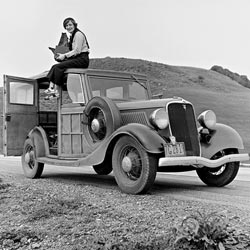Learn more
- Aug 20, 2008
A good data browser allows you to navigate the knowledge space by car
Or so I would like to paraphrase David Huynh’s words that I read today on the W3C’s Semantic Web mailing list, where he wrote in response to Michiel Hildebrand:
It’s very perceptive of you to ask about the tasks that Parallax is presumed to address, and who the users are. I don’t have a specific answer beside “browsing graph of data more efficiently”.
I tend to think that contemporary graph-based data browsers either fly the user at 50,000 feet and show her the whole world in one window below (render a huge data graph as a huge visual graph), or leave her at the street level to wander around on foot (single resource view). I’m just wishing to provide her a car. Perhaps the good thing is that the car doesn’t come with a destination built in. (It’d be quite bad in real life if you need different cars to go grocery shopping and to go to work, for example.)
I quite like this metaphor he uses to describe the motivation behind Parallax, the UI prototype David designed as a novel way to browse Freebase data. It also ties in nicely with a wish made by Richard Cyganiak in an interview with him we published yesterday:
On the top of my wish list would be a really good data browser. The current crop of data browsers for RDF, such as Tabulator, Disco and the OpenLink browser, are still very basic and geeky. I hope for some sort of “Excel for Web dataâ€, an application that allows me to browse through different datasets, find the bits that are relevant to my problem, and lets me slice and dice and correlate the data in different ways. I think such an app would be key to the kind of serendipitous reuse I mentioned earlier.
In the mailing list post cited above, David pointed to the Spellbound blog where Jeanne Kramer-Smyth published a showcase of faceted browsing across Olympics games facts using Freebase Parallax and suggested that Parallax would be particularly useful for exploring connected information:
Now take this idea to the world of archives and libraries, OPACs and finding aids and imagine the sorts of questions you can start asking. Yes – it does depend on the data being connected, but that is happening more and more all the time. The promise of the semantic web is structured data everywhere we turn.

![Reblog this post [with Zemanta]](http://img.zemanta.com/reblog_e.png?x-id=1974531b-b7ee-44d5-b916-d3f07515428e)